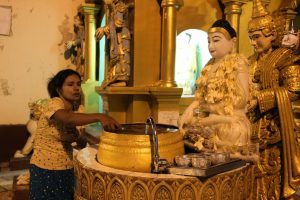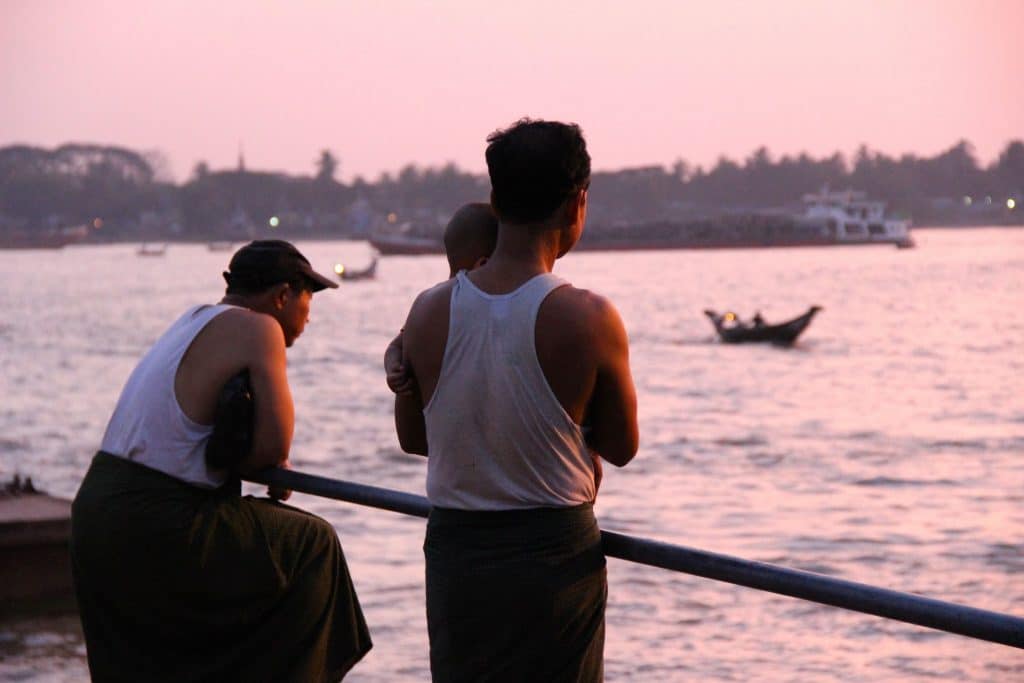
After decades of self-imposed seclusion, the “Republic of the Union of Myanmar” — often referred to as Myanmar, or sometimes Burma — has been opening up to the rest of the world. Intrigued to see a country I had heard so much about in the news I booked a plane ticket, wanting to see if my belief that corruption overshadowed the true sense of Myanmar and the beauty of its people and culture was true.
Yangon, the biggest city in Myanmar, often gets overlooked by travelers who stop by for a day at most; however, this is the perfect starting point to expand your knowledge on local traditions and customs by experiencing, as much as you can, urban life the way the locals do. Which is exactly what I do.

Taking The Circle Line
At Yangon’s Central Station I hop on a 3-hour train ride around the city and countryside. While more luxurious cars are available, I opt for the ‘ordinary’ class. Sure, it’s the cheapest class without AC, but the large picture windows allow for stunning photographs. Plus, I’m able to explore like a local, and isn’t that what travelling is all about?
On board I relax and enjoy the sights: markets, rice fields, countryside, bustling villages and much more. I certainly find the outside views interesting, but what makes the journey even more extraordinary to me is what happens inside the train.

People hop on and off with bags of vegetables and fruits that they unload at each station through open spaces located between each wagon, or through the ‘missing’ window spaces. Lovers hold hands and look at each other with passion. Ice lolly and fruit vendors walk across the wagons trying to find customers.

Most locals wear thanaka, the white creamy paste made from ground bark typically applied on the face in locally attractive ways. The most popular design is the circular patch on both cheeks. Thanaka is also used for its cooling sensation, as a sun protection paste and to improve skin complexion.
Possibly the best part of the ride is interacting. For example, while talking with my travel partner about how we missed out on buying fruits on the train as the produce vendor had already left, a very friendly Buddhist nun comes to our rescue, holding out a bag of fresh mandarines.

Admiring The Swedagon Pagoda
With close to 90% of the country’s population following Buddhism, I also want to find out more about local perceptions of life from people known for their generosity and piety, and visit some of the most stunning holy sites dotting the city’s landscape.
It doesn’t take long for me to realize exploring Yangon would not be complete without a visit to the mesmerizing Swedagon Pagoda, often referred to as ‘the crown of Burma.” I have seen many other Buddhist temples while travelling around Southeast Asia, but this shrine, the most revered in Myanmar, stands out in all manners — as much in its historical and spiritual importance as in its physical majestic beauty. Dominating Yangon’s skyline, it is said to contain the relics of the four Buddhas who have attained enlightenment.

I choose sunset as my time to visit, as it’s both when the weather starts becoming bearable and when the changing colors of the pagoda are the most visually attractive. The magnificent stupa topping the central gold plated dome contains more than 7,000 rubies, diamonds, sapphires and topaz, and there is a big emerald stone positioned to reflect the last sun rays. Tip: The place itself is gigantic and could easily take you a day or two to tour, so make sure to leave enough time for this in your itinerary.

Another must is to go to your birthday station around the pagoda. In Burmese Buddhism, it is essential to know on which day of the week you were born since it determines your planetary post. At the Swedagon Pagoda, there are eight separate stations, or planetary posts; one for each day of the week, including two for Wednesdays as the day is split in half with one ‘a.m’ post, and one ‘p.m’ post. Before heading to the pagoda, I do some quick research and figure out mine is Thursday. Now, I’m able to visit my station, grab a bowl and pour water on top of Buddha’s head for good luck. Religious devotees also offer flowers and coloured flags in a symbolic act of giving.

One thing to remember is that, as a sign of reverence, they require you to be modestly dressed. This means your shoulders — and ideally your arms until the elbows — must be covered. It’s also better to wear long, or at least knee length trousers or skirts. Lastly, it is expected for you to walk around barefoot. These might seem to be small details for some, but they are essential in not getting anyone offended.

Sule Pagoda & Surroundings
Located in the very heart of downtown Yangon, the Sule Pagoda might not be as visually impressive as the Swedagon Pagoda, but is definitely worth a visit for its historical, religious and political significance. The golden stupa is believed to enshrine a sacred hair relic and to be over 2,000 years old, although it has been rebuilt at a later date. The Sule Pagoda is also the landmark for the 1988 uprisings and the more recent 2007 Saffron Revolution as it served as the rallying point.
A couple of times, I decide to make my way there just to stroll around the area. The park next to the Sule Pagoda is one of my favorite places to hang out as it provides just enough green space to relax and engage in people-watching. As a romantic place in downtown Yangon, you often see lovers walking around and religious devotees performing acts of merit.

There are some beautiful monuments and buildings worth noting too, such as the independence pillar, the Immanuel Church, the architecturally impressive and imposing City Hall, the colonial style Supreme Court, and the nearby mosque.

But being downtown is not only about seeing specific places, it is about getting lost in these old, charmingly rundown streets. I walk for hours without getting tired of the sights, smells, colors, and movement around me; my surroundings constant reminders that traveling is not about the destination, but about the journey.

If you like jewelery, head to one of the shops to buy affordable jade. I fall in love with the elephant keyrings made in beautiful jade for only 1USD each. Textile shopping is also an option, and it is possible to find some good quality and reasonably priced beautiful ethnic fabrics. I also come across the widely available betel quid, or ‘nut,’ consisting of tobacco, and areca nuts wrapped in a betel leaf. Like coffee or tea, it is known to give addicts a lift when chewing it. If you see locals smiling with red stained teeth, no need to look further. It is the result of years of chewing betel nuts.

Watching The Sunset At The Jetty (Port)
From downtown Yangon, I walk to the port, referred to as ‘jetty’ in Myanmar. From here, the pink sunsets and short 10-minute boat rides across the river and back add a special ambiance to my stay. I find the jetty to be the ideal place to observe the life of people who need to commute on a daily basis between their hometown and the business capital. Every day, thousands of workers cross the river to sell their local products in Yangon. As there is no bridge connecting the townships to the city, crossing by ferry boat is their only means of transportation.

My tummy rumbles, and I realize I haven’t eaten in awhile. Luckily, the jetty is also known for its street food-filled market – not to mention a trendy Lanthit Jetty. This beer hall/gastropub, adjacent to the TS1 Gallery, is called the Port Autonomy bar. Although quite pricey in local standards, the place offers a good selection of beers, cocktails, and wine. They also have an interesting food menu, and only use regional seafood and local homegrown ingredients in their cuisine. To make it even better, the place is set in a dynamic open air atmosphere against the backdrop of the hectic port.
The 19th Street
The 19th street in Chinatown is famous among travellers. It doesn’t take me long to find out why: cheap drinks – Mojitos are worth 800 kyats (~0.74 USD) only – and some of the best barbecue places where you pick your own meat, fish and veggies that the restaurant’s chef then grills for you. It’s a popular area for solo travelers, as well, due to its friendly nature.

Trying The Local Cuisine
A must try in Myanmar is the Shan Noodles dish, originally from the Northern Shan State, available in most restaurants around the city as the Shan community is one of the most important in Yangon. You eat it with chicken or beef, or if you’re a vegetarian, you can ask it with no meat.
There’s also the local curries, which come in the form of a ‘stir-fry’ rather than a ‘thick soup’ and are delicious accompanied with rice. Make sure to order the tasty ginger salad and papaya salad at least once during your trip as an accompaniment. And if you have a sweet tooth like me, a good option then is the sugar paratha; a multi layered fried flat bread with sugar on top! They are most often eaten in the morning for breakfast, or in the afternoon as a snack. You definitely won’t be disappointed. Bon appétit!

Have you visited Yangon in Myanmar? Please share your experience in the comments below.
By Sarine Arslanian
Recommended Reads:
7 Days in Myanmar: A Portrait of Burma by Denis Gray, John Falconer & Nicholas Grossman
Lonely Planet Myanmar Travel Guide
Buddhist Art of Myanmar by Sylvia Fraser-Lu
Bonus Myanmar Travel Resources
Trekking Kalaw To Inle Lake: A Beautiful & Culturally Immersive Adventure
14 Best Spiritual Yoga Retreats To Strengthen Your Body, Mind & Soul
Opening Ocean Doors Through Travel: Surf Tourism In Myanmar
The Plight Of Burmese Women Refugees (And How You Can Help)
Latest posts by Sarine Arslanian (see all)
- How To Find Your Purpose Through Mayan Astrology In Guatemala - Jul 5, 2017
- 6 Innovative Tools That Make Travel More Accessible - Jan 23, 2017
- Serenity & Sustainable Tourism On Kenya’s Galu Beach - Nov 21, 2016
- Mursi Women Redefine Beauty With Clay Plates - Mar 30, 2016
- How One Conscious Lifestyle Brand Is Using Fashion To Empower Women - Sep 23, 2015





Hi Sarine,
I’ve never been to Yangon, let alone Myanmar, but it sounds like a wonderful place from what you’ve said here. I find it fascinating that people put thanaka on their face. Interesting, too, that public displays of affection are accepted.
Wow nice pictures and blog is amazing.I walk to the port, referred to as ‘jetty’ in Myanmar.I like boat rides across the river.
Thank you ?